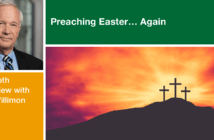How can you position your church for increased attendance and growth? John Zehring, author of Get Your Church Ready to Grow, suggests six strategies that can make your worship more attractive to visitors, without requiring a major investment of time or resources.
1. Explain your time-honored traditions
Integrate into your worship a brief explanation of religious practices and traditions in simple, clear, language. Visitors may have no idea what the “passing of the peace” is, what they are supposed to do, or why they are doing it. Introduce that element of your worship each week with a simple, “Greet one another with a warm handshake or hug, and speak the ancient words of blessing: ‘Peace be with you’ or ‘God’s peace.’” Better to err by overinforming than to leave visitors to fumble along, trying to keep up with your time-honored traditions. Don’t assume, for example, that guests know the Lord’s Prayer, the lyrics for the doxology, choral responses and communion songs.
2. Consider shortening the length of your worship service
Long services have the potential to be a turnoff to guests. If the tradition of the church is to exceed an hour for the worship service, state so in the bulletin. Perhaps at the top of the worship bulletin where the date of the service is listed, a time may also be offered such as 10:00 a.m. to 11:30 a.m., so that guests will know to expect a 90-minute service. Contain the announcements where possible. For services containing added features, consider limiting the length of music.
3. Increase the pace of the worship service
Use more short parts in the service rather than fewer long parts. Remember, many of the people whose spiritual needs you are attempting to meet do not have an extensive church background. Attention spans today are short. Consider how people get their news, weather, and sports in fast-paced, quick-moving, bite-sized chunks. To be sensitive to this reality, speed up the pace of your service with shorter Scriptures, shorter musical pieces, briefer sermons, and less complicated liturgy. Having more brief parts will make the service feel like it moves along faster and will hold the attention of worshippers. For those who were on the fence about whether they wanted to attend church that day, a faster-paced service that captures and holds their attention is a checkmark in the positive direction.
4. Use laity in the worship service
If you say in your bulletin that “all members are ministers” and tout the value of shared ministry, let that conviction shine in the pulpit as participants view their friends and fellow members as worship leaders. If the only people allowed to participate in worship are staff or ordained clergy, it suggests that this is a high church where laity can serve in some roles but are prohibited in others. In contrast, high lay involvement will demonstrate the importance of members in leading nearly every aspect of the church.
5. Feature miniseries of sermons
A miniseries of sermons entices worshippers to return so they do not miss a part of the series. Consider a short sermon series on the Sermon on the Mount, the Ten Commandments, the Beatitudes, the four chapters of Philippians, the most beloved psalms, favorite parables from Jesus, or contemporary issues as they relate to our faith in God. A three- or four-part series holds the potential to increase attendance of those who desire to hear all the parts. Too long a series may lose its impact because of the practical realities that most members do not attend all services.
Have you noticed how popular articles use numbers, such as ten myths, five reasons, three secrets, eight techniques, four tips, and so on? A sermon series can do the same based on, for example, the four best-loved psalms, seven verses for when you feel anxious, three attitudes to propel your forward, or five important women in Jesus’ life. Many verses lend themselves easily to a miniseries. For example: “He has told you, O mortal, what is good; and what does the LORD require of you but to do justice, to love kindness, and to walk humbly with your God?” (Micah 6:8) — a perfect three-week series.
6. Initiate a sermon talkback
Add a sermon talkback or other educational or informational programs immediately following the worship service a couple of times a month and especially invite guests to remain. Not everyone feels comfortable going to coffee hour in the fellowship hall, and some may find it awkward especially when they do not know many people and stand alone with no one to converse with. The ones who do not feel comfortable going to coffee hour may enjoy a more intellectually stimulating conversation in which they do not have to know people. Of course, it is possible to do both — to pick up some refreshments, say hello to friends, and then come to the program.
Excerpted from Get Your Church Ready to Grow: A Guide to Building Attendance and Participation by John Zehring, copyright © 2018 by Judson Press. Used by permission of Judson Press, www.judsonpress.com.
Related Resources
- Making Outsiders Feel like Insiders by Molly Phinney Baskette
- 50 Ways to Welcome New People, a free Lewis Center Resource
- Be the Welcoming Church Video Tool Kit







